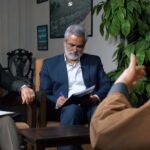One of the important events that took place in the region at that time was the formation of a process of reconciliation through Arab-Israeli negotiations, which is referred to as the “peace process”. This trend was shaped after Arab-Israeli negotiations. Recall that in 1993 an agreement was reached between Mr. Yasser Arafat and the Israelis, represented by Yitzhak Rabin and Shimon Peres; an agreement that was finalized under the auspices of the United States. This agreement was eventually named the “Oslo Accords”. This was naturally a very dangerous issue and had a negative impact on the Arab-Israeli conflict. The danger was that, according to the agreement, the PLO recognized Israel and thus effectively a Palestinian group—not an Egyptian one like Anwar Sadat—abandoned the lands of 1948, the lands occupied by the Zionist regime during the 1948 Arab–Israeli War. Also, in that agreement it was mentioned that the topic of the negotiations would be East Jerusalem, the West Bank and the Gaza Strip and the issue of other parts of Palestine is already done. This was a major fault.
On the other hand, the agreement opened the way for many other Arab countries to begin negotiations and reach an agreement with Israel, eventually normalizing relations with Tel Aviv. This was a very dangerous issue. At that time, the Leader, and the Palestinian resistance groups including Hamas, the Islamic Jihad, and the Popular Front for the Liberation of Palestine opposed the Oslo Accords. The Commander in Chief and some Palestinian groups opposed the deal. So did Hezbollah and the Lebanese groups. We rallied against this agreement but were shot, and we had martyrs for the cause in Beirut’s Southern Dahieh.
In any case, it was a turning point and a very dangerous period. We pondered over what reaction to adopt against the Oslo accord. Should we deal with it politically and through the media, and call on the Palestinians to resist and insist on their rights? The emergence of this issue (the Oslo Accords and the ensuing phase) led to the expansion and consolidation of relations between Hezbollah and Palestinian groups, including Hamas and the Islamic Jihad, and also strengthened the path of resistance in the occupied territories of Palestine. Remember that at that time, a major martyrdom-seeking operation was carried out by Hamas and Islamic Jihad militants in the heart of Tel Aviv and Quds, and shook the Zionist authorities to their core. It was after that operation, that an extraordinary meeting took place in the Egyptian city of Sharm El Sheikh with Clinton and Yeltsin, the then Russian president in attendance. Many countries in the world also attended this meeting. Meanwhile, the late Syrian president Hafez al-Assad rejected participating in the meeting.
The fact is that the meeting finally declared war on three groups: first Hezbollah, second Hamas, and the Islamic Jihad, and the third Islamic Republic of Iran due to its support for the resistance in the region. Despite its large sphere, the meeting did not manage to introduce fear in the ranks of Hezbollah and other resistance groups in the region, especially since at that time, the position of the Leader regarding the resistance—that is continuing the Resistance and persisting on the path— was absolutely straightforward and resolute. Therefore the Oslo accord brought about a series of events; events that were very crucial and hazardous for this procedure.




